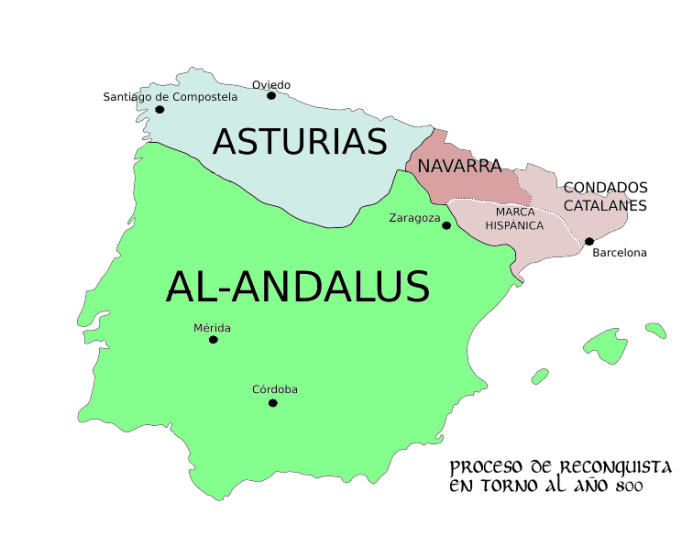Muslims were in the Peninsula for 800 years and they occupied the centre and south of the Peninsula.
But a few small, independent Christian kingdoms grew on the Cantabrian coast and in the Pyrenees.
Christian kingdoms before the year 1000:
- the Kingdom of Asturias was the first and later become the Kingdom of Leon
- the Kingdom of Aragon
- the Kingdom of Navarra
- the Catalonian Counties
- the Kingdom of Castilla
Around 1230 the Peninsula was divided into several large kingdoms:
- kingdom of Navarra: Navarra + La Rioja
- Crown of Aragon: kingdom of Aragon + Valencia + Mallorca + Catalonian Counties
- Crown of Castilla: kingdom of Castilla + kingdom of Leon + Andalucia (except from Granada)
- Portugal

From the 13th to the 15th centuries, the Crowns of Castilla and Aragon conquered many Muslim territories and extended their borders. This is the map of the Peninsula around 1400:

In 1469 the Queen of Castilla, Isabel, and the King of Aragon, Fernando, married and united the Crowns of Castilla y Aragón.
In 1492, towards the end of the Middle Ages, The Catholic Monarchs conquered the Muslim Kingdom of Granada. This was the last remaining land belonging to the fMuslims. This completed the Christian Reconquest.
Society in the Christian Kingdoms was organized as a feudal system. It consisted of three social groups:
- the noblemen: the king was the highest political authority. He gave land to the noblemen and they protected the king. They lived in castles.
- the clergy: include bishops and monks. Monks lived in monasteries.
- the peasants: most of them were serfs, they served a nobleman and gave some of the crops to him. Population in the cities were craftsmen an merchants.





In this picture you can see the relation between the social groups, their occupations and the kind of place they lived in:
copied from a teacher´s blog: click on the picture
picture copied from a teacher´s blog: click on it
Here you have a picure of a monastery and its parts:
picture copied from a teacher´s blog: click on it
Look and identify the different parts of a medieval castle:

For more information you can visit this blog:
And also you can play with this presentation:
Interested in castles? Look at this digital book from a high school:










No hay comentarios:
Publicar un comentario